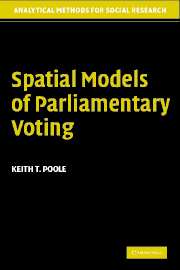Book contents
- Frontmatter
- Contents
- List of Tables and Figures
- Preface
- 1 Introduction
- 2 The Geometry of Parliamentary Roll Call Voting
- 3 The Optimal Classification Method
- 4 Probabilistic Spatial Models of Parliamentary Voting
- 5 Practical Issues in Computing Spatial Models of Parliamentary Voting
- 6 Conducting Natural Experiments with Roll Calls
- 7 Conclusion
- References
- Index
3 - The Optimal Classification Method
Published online by Cambridge University Press: 24 November 2009
- Frontmatter
- Contents
- List of Tables and Figures
- Preface
- 1 Introduction
- 2 The Geometry of Parliamentary Roll Call Voting
- 3 The Optimal Classification Method
- 4 Probabilistic Spatial Models of Parliamentary Voting
- 5 Practical Issues in Computing Spatial Models of Parliamentary Voting
- 6 Conducting Natural Experiments with Roll Calls
- 7 Conclusion
- References
- Index
Summary
Overview
In this chapter I show a method I developed (Poole 1997; 2000a) that is based on the geometry shown in Chapter 2 and is designed to analyze real-world roll call data. Simply put, I add error to the simple spatial model developed in Chapter 2 and show an estimation method – optimal classification (OC) – that maximizes the correct classification of legislative choices. In Chapter 4, I will focus entirely on models that maximize the probabilities of legislative choices using the same error framework. I show OC first because it can be used as a very reliable platform on which to build more intricate estimation methods.
At the heart of OC are two algorithms – the cutting plane procedure and the legislative procedure. Both of these procedures are unique and stable. In particular, Monte Carlo tests show that when the number of legislators is 100 or greater and the number of roll calls is on the order of 500 – typical of national legislatures like the U.S. Senate – then the recovery of the legislators and cutting lines or planes in one to ten dimensions at high levels of error and missing data is very precise (Poole, 1997; 2000a; b). Even with very small data sets, OC produces reliable results. It is a stable building block upon which more complex parametric scaling methods can be constructed.
Within the psychometrics field, the OC scaling method is a nonmetricunfolding procedure.
- Type
- Chapter
- Information
- Spatial Models of Parliamentary Voting , pp. 46 - 87Publisher: Cambridge University PressPrint publication year: 2005



